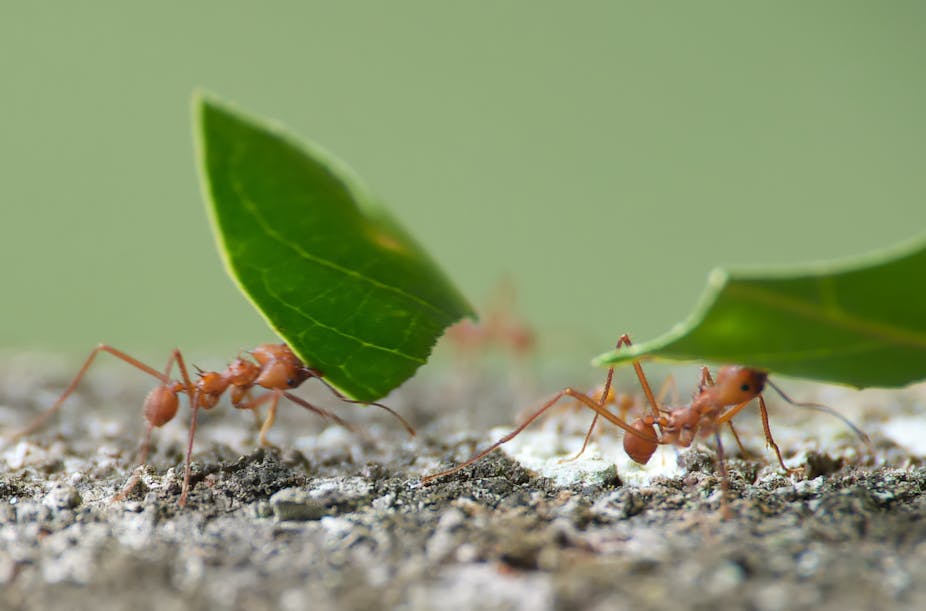We humans have long looked to ants as models for our own societies, from Jean de La Fontaine’s tale of the grasshopper and the ant to modern uses of ant algorithms to solve computational and logistics problems.
One of the intriguing similarities between ant societies and our own involves the construction of transport infrastructure to move the raw materials on which the economy depends.
In a study of leaf-cutting ants in Central America, published today, Andrew Bruce and I discovered cleared trails become less effective at promoting the flow of resources as ant colonies grow larger. We biologists refer to such patterns as “allometric scaling” – the change in the function of an entity as it changes in size.
Leaf-cutting ants (we studied Atta colombica and Atta cephalotes) construct small highways through the tropical forest floor by cutting dead leaves and other vegetation with their mandibles and dragging the litter away from the path. This creates a smooth road surface on which they carry fragments of fresh leaf tissue back to their nest.
There they use the leaf tissue to cultivate fungal gardens that supply the colony with food. We measured the rate at which different colonies retrieved fresh leaf tissue and found an inverse relationship between this harvesting rate and the length of the trails over which the ants travelled.
This makes intuitive sense from the perspective of an individual ant (a journey twice as far will take twice the time and cut an ant’s resource delivery rate in half) but the whole colony could, in principle, overcome a reduction in individual performance by sending more workers out on the trail.
So if individual foragers delivered resources at half the rate, the colony could double the number of workers to maintain a target resource flow. The surprise in our findings was that leaf-cutting ant colonies don’t do this.

Instead, recruitment of worker ants to the resource-harvesting task seemed to be regulated differently in small and large colonies, so that productivity rose less than proportionately with increasing numbers of workers.
This pattern was due entirely to the effect of transport distances on productivity. There was no evidence of slower speeds or compromised performance by individuals, yet bigger colonies were getting less “bang for their buck” than smaller colonies from their investment in cleared roads.
An allometric scaling pattern like this sets an upper limit on the distance at which resources can profitably be harvested, and this in turn probably limits the maximum size of a colony.
In some ways, leaf-cutting ant colonies resemble human cities. Both place a premium on building transport infrastructure. This infrastructure is then used to bring dispersed raw materials from outlying regions into a densely populated centre where the resources are transformed into higher value goods. In this way, transport is at the heart of an urban economy.
For leaf-cutting ants, each additional length of roadway and each additional foraging worker brings smaller and smaller returns, so building more transport infrastructure and exploiting ever-larger foraging territories cannot continually supply the resource demands of growing colony populations.
Human societies may be under similar constraints. It is known the total length of roadways scales less than proportionately with the geographic size of countries: a doubling in area is accompanied by less than a doubling in total road length.
Presumably the returns in material transport and economic productivity cannot keep pace with the increasing distances. Humans have an advantage over ants, however, in the form of technological innovation.
Many measures of social interaction and creativity, such as the numbers of patents, rise faster than proportionately with population size. Larger populations of humans interact more intensively, enhancing economic productivity through innovation.

Ants, in contrast, must await genetic mutation and natural selection for new “ideas” that increase productivity. The fungal gardening economy of leaf-cutting ants is itself an evolutionary innovation with respect to the foraging patterns of most ants.
Most ant species are more like hunter-gatherer societies compared to the leaf-cutters’ centralised urban economy.
It would be interesting to extend our research and discover how foraging and other activity rates scale with colony size and resource transport distances over a wider range of a species with different modes of life. The central question: does evolutionary innovation allow species to increase productivity by escaping the constraints of an old “economic” system?
A change in the scaling relationships between foraging rate and distance would be one signal of such fundamental innovation.

